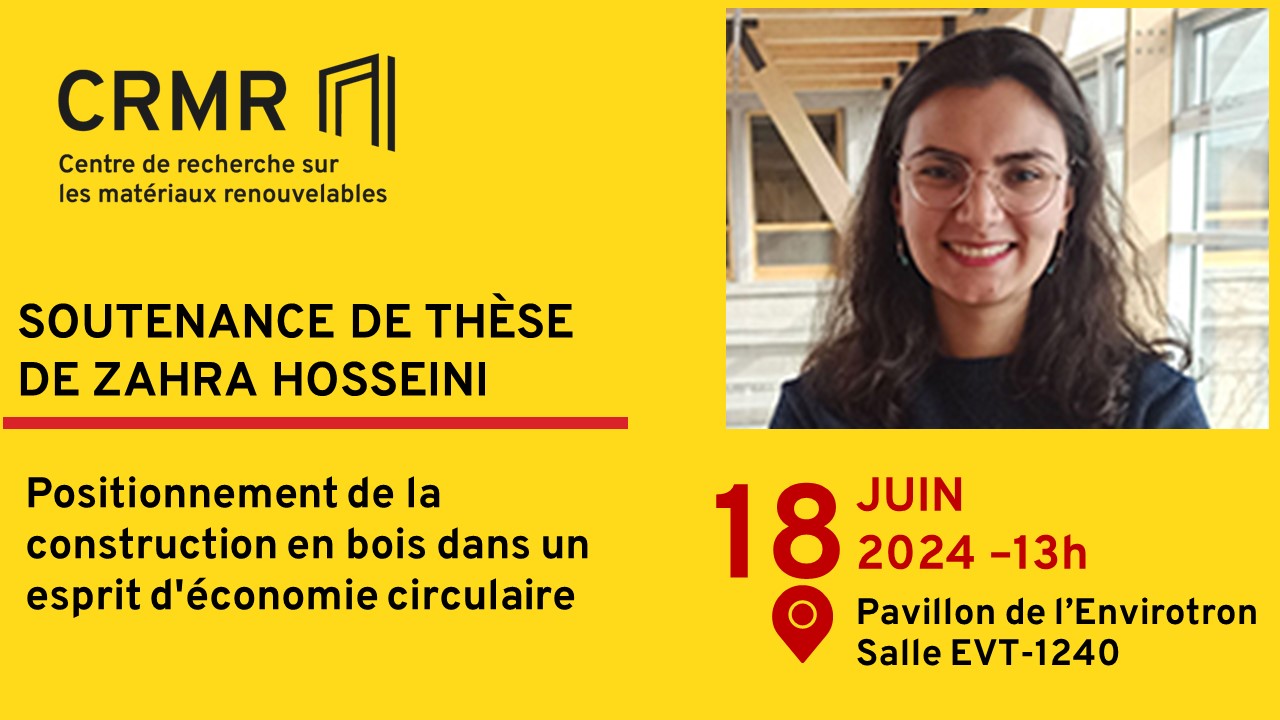Thesis Defence Zahra Hosseini – PhD in wood and bio-based materials engineering
You are cordially invited to attend the thesis defence of Zahra Hosseini, a Ph.D. student in wood and bio-based materials engineering, which will take place in hybrid mode on Tuesday, June 18, 2024, at 1 p.m. (Quebec City time) in EVT-1240.
When and where?
June 18, 2024, at 1 p.m.
Envirotron Pavilion
Room EVT-1240
2480 Hochelaga Blvd.
Laval University, Quebec City
Login link for those wishing to attend online: https://ulaval.zoom.us/j/65017094778?pwd=gDnPq27eB0DxXsF5qfxIaU6EtTcvqg.1
Welcome to all!

The members of the jury are:
Véronique Landry, President
Faculty of Forestry, Geography and Geomatics – Laval University
Pierre Blanchet, Research Director
Faculty of Forestry, Geography and Geomatics – Laval University
Bertrand Laratte, Research Co-Director
Arts et Métiers Institute of Technology, France
Jean-Luc Kouyoumji, external examiner
FCBA Institute of Technology
Ben Amor, examiner
Faculty of Engineering, Sherbrooke University
Geraud Essoua, examiner
Vertima
Thesis title: Positioning Wood Construction in the Spirit of the Circular Economy
Abstract: The adoption of circular economy (CE) principles in the construction sector offers a transformative shift from a linear to a circular approach, characterized by extending material lifespan, implementing smarter manufacturing processes, and valorizing waste streams. This transition results in lowering the associated environmental impacts associated with the sector, thereby fostering greater sustainability. This thesis, divided in three axes, examines the integration of wooden constructions within the CE paradigm, with a particular emphasis on end-of-life (EoL) strategies for building materials. Within the first axis, a conceptual framework was proposed to guide the application of various CE strategies. In the second axis, four construction systems in Quebec, Canada were compared with the life cycle assessment (LCA) method, based on the current EoL strategies, and when the circularity of the materials was increased at the EoL. Finally, the third axis focused on the development of circular trails to integrate more CE strategies in the current EoL practices in the construction sector.
In the first axis, at first, a definition for CE was elaborated within the scopes of the study. Then, based on the definition, a conceptual framework was developed. This framework showed how different circular economy strategies could be applied to the EoL of the building materials and how their application should be evaluated.
The second axis compared four common building systems (mass timber, concrete, steel, and light wood frame) in Quebec, Canada using the life cycle assessment (LCA) method. The analysis, conducted under various scenarios, revealed that EoL practices for construction and demolition waste (CDW) in Quebec currently have very low circularity. The results of this axis showed that despite higher recycling rates of CDWs in other regions, the environmental gains remained relatively low, and that the application of CE should not be limited to only increasing the recycling strategy. Furthermore, the light wood frame structure demonstrated lower environmental impacts across all scenarios, while the mass timber structure exhibited significant potential for impact reduction with increased circularity at EoL.
Within the third axis, short-term and long-term circular trails were developed for the mass timber building as this system was identified as having more potential for lowering the environmental impacts within more circularity. These trails outlined four detailed EoL practices for each of the CDWs of the studied building, resulting in remarkable decrease in climate change and eutrophication environmental impact categories compared to current EoL practices in Quebec. The developed short-term trails proposed an optimized increase in the circularity of current EoL practices, while long-term trails encouraged comprehensive changes in the material selection and development of infrastructure to apply higher levels of circularity in the construction sector.

